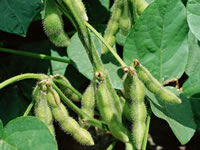Glycine max
English: Soy Bean
Sanskrit/Indian: Soya Bean
Russian: Соя

General information:
Glycine max is an annual herbaceous plant in the Fabaceae (legume or bean family) that originated in southeastern Asia that was domesticated more than 3,000 years ago for its edible seeds and young pods. The soybean plant, which is densely hairy on leaves and stem, can grow to nearly 2 m (6 ft) tall, although commercial varieties are more typically 0.3 to 0.9 m (1 to nearly 3 ft). Leaves are compound, with 3 leaflets. The inconspicuous, stalkless white to purple flowers are borne singly or in small clusters in the axils (where leaf meets stem). The fruit is a broad, hairy, flattened legume or pod, around 10 cm (3 in) long, yellow to brown when fully mature and dried. Pods typically contain up to 4 beans, which vary in size and color depending on cultivar (colors range from white to reddish to black)
Constituents:
The lipid portion of the seed contains four phytosterols: stigmasterol, sitosterol, campesterol,and brassicasterol accounting for about 2.5% of the lipid fraction; and which can be converted into steroid hormones. Soy contains isoflavones like genistein and daidzein. It also contains glycitein, an O-methylated isoflavone which accounts for 5–10% of the total isoflavones in soy food products
Benefits:
Functional components of soy and their impact
- Linolenic acid : Essential fatty acid, hypotriglyceridemic, improves heart health
- Isoflavones : Estrogenic, hypocholesterolemic, improves digestive tract function, prevents breast, prostate, and colon cancer, bone health, improve lipid metabolism
- Lecithins : Improve lipid metabolism, improve memory and learning abilities
- Lectins : Anti-carcinogenic, immunostimulator
- Linoleic acid : Essential fatty acid, hypocholesterolemic
- Peptides : Readily absorbed, reduce body fat, anticancer
- Phytosterols : Hypocholesterolemic, improves prostate cancer
- Protein : Hypocholesterolemic, antiatherogenic, reduces body fat
- Saponin : Regulates lipid metabolism, antioxidant
